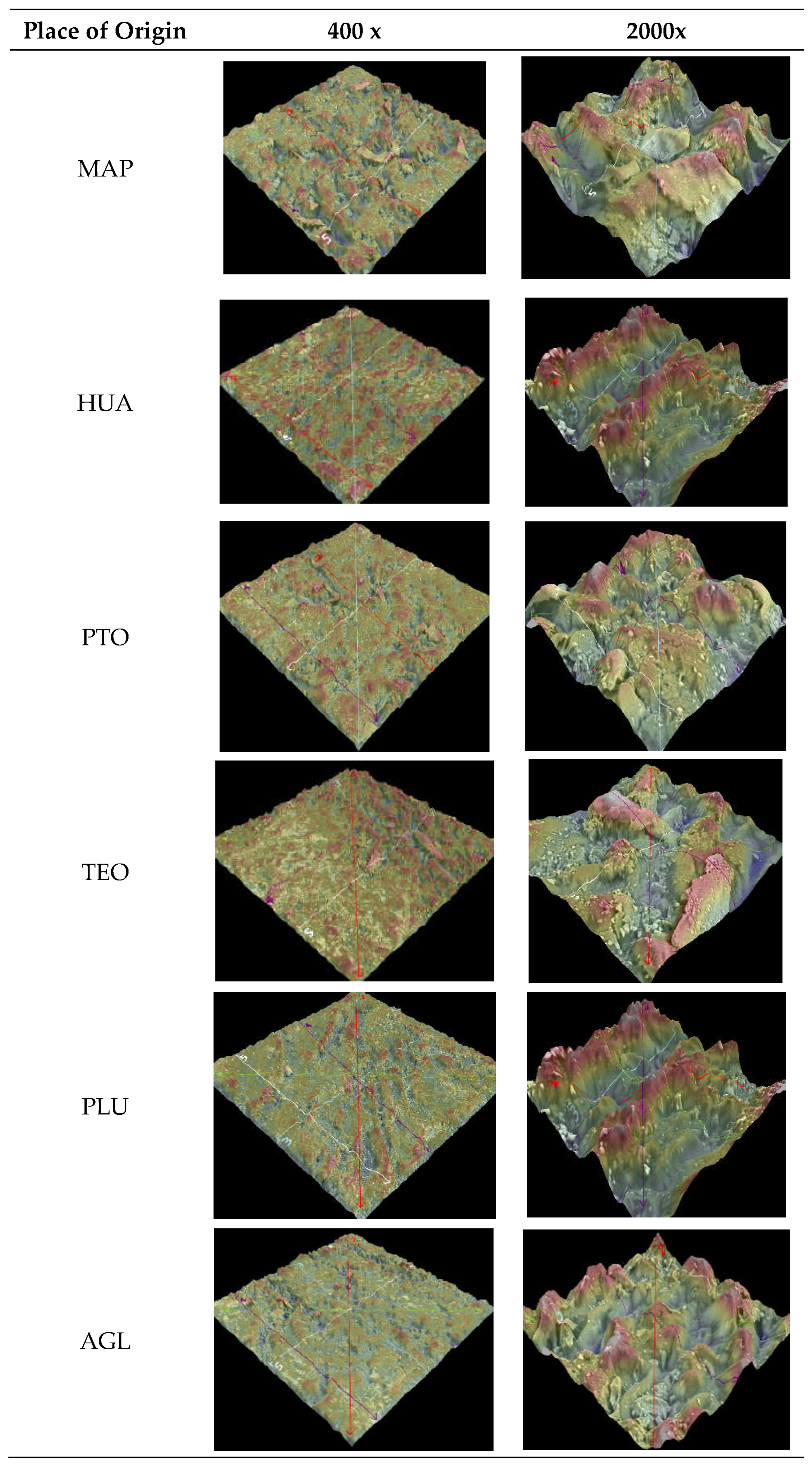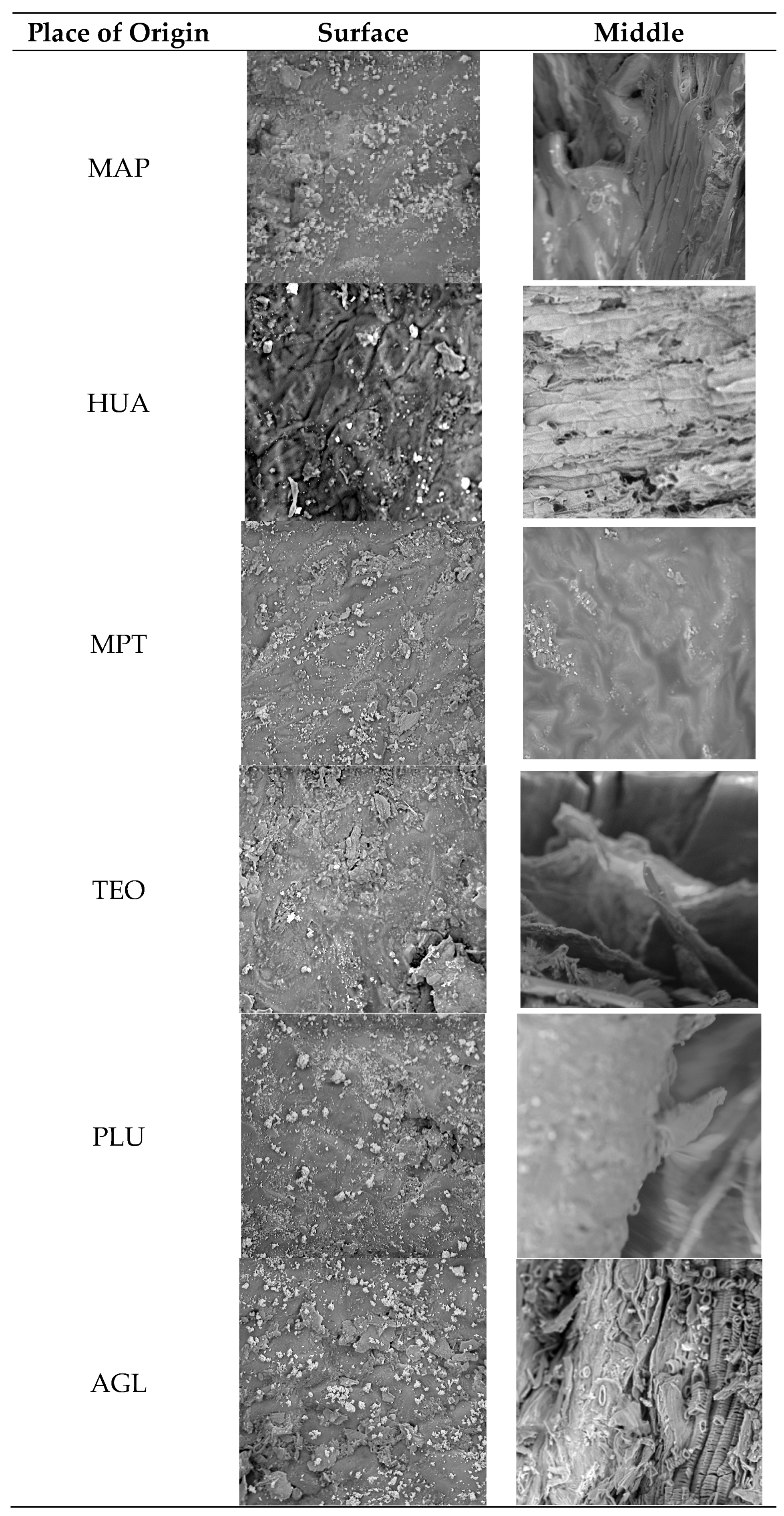Submitted:
02 May 2024
Posted:
06 May 2024
You are already at the latest version
Abstract
Keywords:
1. Introduction
2. Materials and Methods
2.1. Samples of specialty Coffea arabica L. with denomination of origin “Pluma”
2.2. SEM analysis of Coffea arabica L. grains
2.3. Statistical analysis
3. Results and Discussion
4. Conclusions
Author Contributions
Funding
Data Availability Statement
Acknowledgments
Conflicts of Interest
References
- A. C. Ceoromila et al., “Effect of ground and roasted parameters on both the microstructure of arabica coffee beans and coffee infusion,” no. December, 2020. [CrossRef]
- T. Klingel, J. I. Kremer, V. Gottstein, and T. R. De Rezende, “A Review of Co ff ee By-Products Including Leaf ,” Foods, vol. 9, pp. 1–20, 2020.
- T. Lu, Y. Sun, Y. Huang, and X. Chen, “Effects of roasting on the chemical compositions, color, aroma, microstructure, and the kinetics of changes in coffee pulp,” J. Food Sci., vol. 88, no. 4, pp. 1430–1444, 2023. [CrossRef]
- Mihailova, B. Liebisch, M. D. Islam, J. M. Carstensen, A. Cannavan, and S. D. Kelly, “The use of multispectral imaging for the discrimination of Arabica and Robusta coffee beans,” Food Chem. X, vol. 14, no. May, p. 100325, 2022. [CrossRef]
- NOM, NOM-255-SE. 2022, pp. 1–25.
- T. Dippong, M. Dan, M. H. Kovacs, E. D. Kovacs, E. A. Levei, and O. Cadar, “Analysis of Volatile Compounds, Composition, and Thermal Behavior of Coffee Beans According to Variety and Roasting Intensity,” Foods, vol. 11, no. 19, 2022. [CrossRef]
- T. Juárez González, Y. I. Maldonado Astudillo, R. González Mateos, M. O. Ramírez Sucre, P. Álvarez Fitz, and R. Salazar, “Caracterización fisicoquímica y sensorial de café de la montaña de Guerrero,” Rev. Mex. Ciencias Agrícolas, vol. 12, no. 6, pp. 1057–1069, 2021. [CrossRef]
- S. Jung, S. Gu, S. H. Lee, and Y. Jeong, “Effect of roasting degree on the antioxidant properties of espresso and drip coffee extracted from coffea arabica cv. Java,” Appl. Sci., vol. 11, no. 15, 2021. [CrossRef]
- S. Suárez Cunza, E. Alfaro Pillihuaman, and E. G. Ramírez Roca, “ACTIVIDAD ANTIOXIDANTE, POLIFENOLES Y FLAVONOIDES DE Coffea arabica de CINCO REGIONES PERUANAS,” Rev. la Soc. Química del Perú, vol. 86, no. 4, pp. 343–354, 2021. [CrossRef]
- T. Toci, D. A. Azevedo, and A. Farah, “Effect of roasting speed on the volatile composition of coffees with different cup quality,” Food Res. Int., vol. 137, no. April, 2020. [CrossRef]
- J. A. Jiménez-Mendoza, N. F. Santos-Sánchez, A. D. Pérez-Santiago, M. A. Sánchez-Medina, D. Matías-Pérez, and I. A. García-Montalvo, “Preliminary Analysis of Unsaturated Fatty Acid Profiles of Coffea arabica L., in Samples with a Denomination of Origin and Speciality of Oaxaca, Mexico,” J. Oleo Sci., vol. 72, no. 2, pp. 153–160, 2023. [CrossRef]
- F. Sarghini, E. Fasano, A. De Vivo, and M. C. Tricarico, “Influence of roasting process in six coffee Arabica cultivars: Analysis of volatile components profiles,” Chem. Eng. Trans., vol. 75, no. December 2018, pp. 295–300, 2019. [CrossRef]
- K. Król, M. Gantner, A. Tatarak, and E. Hallmann, “The content of polyphenols in coffee beans as roasting, origin and storage effect,” Eur. Food Res. Technol., vol. 246, no. 1, pp. 33–39, 2020. [CrossRef]
- M. Ormaza, F. O. Díaz, and B. A. Rojano, “Effect of coffee aging (coffea arabica l. Var. Castillo) on the composition of total phenols, flavonoids, chlorogenic acid and antioxidant activity,” Inf. Tecnol., vol. 29, no. 3, pp. 187–196, 2018. [CrossRef]
- M. Bolka and S. Emire, “Effects of coffee roasting technologies on cup quality and bioactive compounds of specialty coffee beans,” Food Sci. Nutr., vol. 8, no. 11, pp. 6120–6130, Nov. 2020. [CrossRef]
- E. Nakilcioğlu-Taş and S. Ötleş, “Physical characterization of arabica ground coffee with different roasting degrees,” An. Acad. Bras. Cienc., vol. 91, no. 2, pp. 1–15, 2019. [CrossRef]
- F. M. Borém, P. D. de Oliveira, E. P. Isquierdo, G. da S. Giomo, R. Saath, and R. A. Cardoso, “Borem, F. M. al.,” Coffee Sci., vol. 8, no. 2, pp. 218–225, 2013.
- D. N. Raba, D. R. Chambre, D. M. Copolovici, C. Moldovan, and L. O. Copolovici, “The influence of high-temperature heating on composition and thermo-oxidative stability of the oil extracted from Arabica coffee beans,” PLoS ONE, vol. 13, no. 7, pp. 1–13, 2018. [CrossRef]
- Y. Chen, R. Guo, F. Ma, H. Zhou, M. Zhang, and Q. Ma, “Effect of Coffee Grounds/Coffee Ground Biochar on Cement Hydration and Adsorption Properties,” Materials (Basel)., vol. 17, no. 4, p. 907, 2024. [CrossRef]
- L. Gao, S. Mei, H. Ma, and X. Chen, “Ultrasonics Sonochemistry Ultrasound-assisted green synthesis of gold nanoparticles using citrus peel extract and their enhanced anti-inflammatory activity,” Ultrason. Sonochem., vol. 83, p. 105940, 2022. [CrossRef]
- M. Rodrigues da Silva et al., “Metabolite characterization of fifteen by-products of the coffee production chain: From farm to factory,” Food Chem., vol. 369, no. August 2021, 2022. [CrossRef]
- W. Dong, K. Cheng, R. Hu, Z. Chu, J. Zhao, and Y. Long, “Effect of microwave vacuum drying on the drying characteristics, color, microstructure, and antioxidant activity of green coffee beans,” Molecules, vol. 23, no. 5, 2018. [CrossRef]
- Mariem Fersi, R. Hajji, K. Mbarki, I. Louati, and N. J. A. H. R. Hachicha, “Spectroscopic and microscopic characterization of humic acids from composts made by co-composting of green waste, spent coffee,” Environ. Technol., 2024. [CrossRef]
- E. Afonso, S. National, P. Tiemblo, and S. National, “La perfilometría óptica como técnica de caracterización topográfica no destructiva y sin contacto,” no. July, 2020.
- L. H. Robledo-Taboada, J. F. Jiménez-Jarquín, M. Flores-Castañeda, A. Méndez-Blas, J. Barranco-Cisneros, and S. Camacho-López, “Single-step femtosecond laser-induced formation of coexisting microstructures in silicon,” Bull. Mater. Sci., vol. 46, no. 2, 2023. [CrossRef]
- G. Canseco, Traditional Aromatic Coffee. Oaxaca, México, 2020.
- R. Feria-Reyes et al., “Pine Bark as a Potential Source of Condensed Tannin: Analysis through Fourier Transform Infrared Spectroscopy (FTIR), Scanning Electron Microscopy (SEM), and Energy Dispersive X-ray (EDX),” Forests, vol. 14, no. 7, 2023. [CrossRef]
- S. Oestreich-Janzen, Caracterización físico-química y sensorial de dos variedades de café (Coffea arabica) del occidente de Honduras, no. March. Elsevier Inc., 2013.
- N. Cordoba, M. Fernandez-Alduenda, F. L. Moreno, and Y. Ruiz, “Coffee extraction: A review of parameters and their influence on the physicochemical characteristics and flavour of coffee brews,” Trends Food Sci. Technol., vol. 96, pp. 45–60, 2020. [CrossRef]
- G. A. L. Torres, L. V Zezzo, R. Greco, and P. P. Coltri, “Exposure To Climate Risk : A Case Study For Coffee Farming In The Region Of Alta Mogiana , São Paulo,” vol. 94, pp. 1–21, 2022. [CrossRef]
- L. P. Figueiredo, F. M. Borém, M. R. Almeida, L. F. C. de Oliveira, A. P. de C. Alves, and C. M. dos Santos, “Raman spectroscopy for the differentiation of Arabic coffee genotypes,” Food Chem., vol. 288, no. January, pp. 262–267, 2019. [CrossRef]
- J. M. Clemente, H. E. P. Martinez, A. W. Pedrosa, Y. Poltronieri Neves, P. R. Cecon, and J. L. Jifon, “Boron, copper, and zinc affect the productivity, cup quality, and chemical compounds in coffee beans,” J. Food Qual., vol. 2018, 2018. [CrossRef]
- F. Vezzulli, M. C. Fontanella, G. M. Beone, and M. Lambri, “Specialty and high-quality coffee : Discrimination through elemental and ICP-MS / MS of origin , species , and variety,” no. November 2022, 2023. [CrossRef]
- L. H. Reichembach, G. K. Kaminski, J. B. Baron Maurer, and C. L. Oliveira Petkowicz, “Fractionation and characterization of cell wall polysaccharides from coffee (Coffea arabica L.) pulp,” Carbohydr. Polym., vol. 327, 2024, [Online]. [CrossRef]
- J. Sim, C. Mcgoverin, I. Oey, R. Frew, and B. Kebede, “Near-infrared reflectance spectroscopy accurately predicted isotope and elemental compositions for origin traceability of coffee,” Food Chem., vol. 427, no. June, p. 136695, 2023. [CrossRef]
- J. Árvay et al., “Concentration of Micro- and Macro-Elements in Green and Roasted Coffee : Influence of Roasting Degree and Risk Assessment for the Consumers,” 2018.


| Place of Origin | Coffee grain samples | Altitude (masl) | Location |
|---|---|---|---|
| MAP |  |
1000 | Coordinates 96°20’ west longitude, 16°00’ north latitude. Bordered on the north by the municipality of San Marcial Ozolotepec and Santiago Xanica; on the south by Pluma Hidalgo and Santa Maria Huatulco; on the east by Pluma Hidalgo and San Pedro el Alto; on the west by San Miguel del Puerto. |
| HUA |  |
1058 | Coordinates: 15°50’ north latitude and 96°19’ west longitude. Bordered on the south by the Pacific Ocean; on the north by San Miguel del Puerto and San Mateo Piñas; on the southeast by San Miguel del Puerto; on the west by San Pedro Pochutla and Pluma Hidalgo. |
| PTO |  |
1149 | Coordinates: 96°10’ west longitude, 15°55’ north latitude. Bordered on the north by Santiago Xanica; on the south by the Pacific Ocean; on the east by San Pedro Huamelula and San Carlos Yautepec; on the west by Santa María Huatulco. |
| TEO |  |
1200 | Coordinates 16°35’ north latitude and 97°13’ west longitude. It is bordered on the north by Santiago Xochiltepec, on the east by San Lorenzo Texmelucan; on the west by Santa María Zaniza and Zenzontepec; on the southwest by San Jacinto Tlacotepec; on the south by Santiago Minas. |
| PLU |  |
1343 | Coordinates 96°25’ west longitude, 15°55’ north latitude. It borders with Huatulco Bays and is located east of the State of Oaxaca. |
| AGL |  |
1820 | Coordinates 16°01’ north latitude and 96°37’ west longitude. It is bordered to the north by the municipality of San Pedro el Alto; to the south by San Agustín Loxicha; to the east by Pluma Hidalgo; to the west by San Agustín Loxicha. Its approximate distance to the state capital is 180 kilometers. |
| Rz (µm) | Ra (µm) | |||
|---|---|---|---|---|
| Place of Origin | 400 x | 2000 x | 400 x | 2000 x |
| MAP | 34.18±1.15a | 19.86±2.48a | 8.27±0.82a | 8.38±1.68a |
| HUA | 26.62±2.31b | 21.85±6.63a | 5.75±0.46b | 11.53±1.65a |
| PTO | 25.93±2.69b | 16.33±2.33a | 5.20±0.47b | 6.55±0.94ab |
| TEO | 27.54±5.31b | 13.85±1.66ab | 6.16±1.83b | 7.22±2.17ab |
| PLU | 26.43±0.37b | 21.02±0.64a | 5.55±0.48b | 10.94±0.53a |
| AGL | 26.53±3.13b | 18.26±3.47ab | 5.73±0.28b | 7.58±0.87ab |
| Place of Origin | Surface | Middle | ||||
|---|---|---|---|---|---|---|
| 6C | 8O | 20Ca | 6C | 8O | 7N | |
| MAP | 75.54 | 23.58 | ND | 54.17 | 32.57 | 13.26 |
| HUA | 78.97 | 21.03 | ND | 55.65 | 44.45 | ND |
| PTO | 77.17 | 22.63 | ND | 67.91 | 17.05 | 15.04 |
| TEO | 81.14 | 18.86 | ND | 57.18 | 30.82 | 12.01 |
| PLU | 73.06 | 26.27 | ND | 76.55 | 23.33 | ND |
| AGL | 66.48 | 28.69 | 4.5 | 54.29 | 35.65 | 10.06 |
Disclaimer/Publisher’s Note: The statements, opinions and data contained in all publications are solely those of the individual author(s) and contributor(s) and not of MDPI and/or the editor(s). MDPI and/or the editor(s) disclaim responsibility for any injury to people or property resulting from any ideas, methods, instructions or products referred to in the content. |
© 2024 by the authors. Licensee MDPI, Basel, Switzerland. This article is an open access article distributed under the terms and conditions of the Creative Commons Attribution (CC BY) license (http://creativecommons.org/licenses/by/4.0/).





